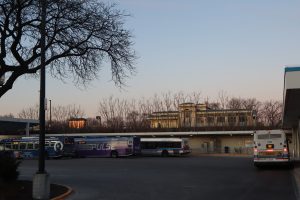RTA calls for stronger oversight, raising fares, more state funding
By Igor Studenkov for Chronicle Media — February 14, 2025
Jefferson Park Transit Center serves as a hub for CTA, Metra and Pace buses and trains. (Photo by Igor Studenkov/for Chronicle Media)
As state legislators consider a bill that would merge four Chicago area transit agencies into one, the Regional Transportation Authority made a reform proposal of its own.
While the RTA is supposed to provide oversight over the CTA, Metra and Pace, in practice, its influence is limited. The proposal unveiled on Jan. 15 would significantly strengthen the RTA’s role, giving it the responsibility for setting fares and planning capital projects, as well giving the RTA power to withhold funds if the transit agencies don’t meet certain performance standards. It argues that the consolidation, along with an across-the-board 10 percent fare increase and around $300 million increase in annual state funding, would make Chicago area transit more efficient and user friendly.
The proposal comes as state legislators mull the bill that would combine the four agencies into the Metropolitan Mobile Authority, with supporters arguing that system overhaul is necessary before the state increases funding. The CTA, Metra and Pace pushed back, arguing that the current structure balances the interests of Chicago, suburban Cook County and the collar counties.
While the RTA had been more open to the idea, it expressed concerns that some services might get short-changed. It also worried that the consolidation could take years, too late to address the fiscal cliff.
The RTA was established in 1974 to help fund public transit. The Regional Transportation Authority Act of 1983 moved the CTA under the RTA umbrella and established separate commuter rail and suburban bus divisions that became Metra and Pace. The RTA got the final say over each agency’s operating and capital budgets, and it was responsible for distributing federal grants and collecting sales tax revenue. Each agency set its own fares and planned services. The reform proposal noted that, under the RTA Act, it only has a month to review budgets — which, it argues, isn’t enough time for meaningful oversight.
The ridership currently lags the pre-pandemic numbers, it recovered much better on off-peak hours and weekends. The three agencies have been using federal stimulus funds to balance the budget, but those are expected to run out in 2026.
The transit agencies have been simplifying fare structures and moving away from rush-hour based scheduling model, but they all argued that there is no way to avoid the fiscal cliff without an increase in state funding. The state and federal funding currently mostly goes into the capital budget. The operating expenses are mostly funded through combination of tax revenue and fares, with state providing matching funds based on sales tax revenue.
In a statement announcing the proposal’s release, RTA Executive Director Leanne Redden argued that the setup was flawed even before the pandemic.
“Our regional transit system has been drastically underfunded for decades; while systems in New York, Boston and Philadelphia get up to 50 percent of their funding from their state governments, state funding here makes up about 17 percent,” said the RTA.
The MMA proposal would increase state support, but the RTA raised concerns that it’s not clear how that money would be distributed to various aspects of public transit.
The RTA estimates that, without stimulus funding, Chicago area transit would face an approximately $770 million funding shortfall. But it estimates that consolidating some of the functions within the RTA would save $50 million, and a 10 percent fare increase would save another 50 million. Assuming the RTA preserves the existing fare structure, the 10 percent increase would mean ‘L’ train fares would increase from $2.50 to $2.75, CTA bus fares would increase from $2.25 to $2.48, Pace bus fares would increase from $2 to $2.20 and Metra fares would increase from $3.75-$6.75 to $4.13-$7.43.
Fare integration was something that eluded the Chicago region for as long as the RTA existed. The major obstacle has been that the CTA and Pace charge the same fare for every trip, while Metra uses distance-based fare. Last year’s Metra fare overhaul simplified its fare structure by dropping the number of fare zones from 11 to four and creating a flat $3.75 fare for all trips outside downtown Chicago.
The RTA is asking the state to give it the power to set fares and create a single fare system. The three systems already use the same app, the Ventra app, but because of the difference in fare structures, riders can seamlessly transfer between the CTA and Pace, but not to and from Metra, and they can’t use the Ventra balance to pay for Metra tickets.
In a notable shift, the RTA is proposing to set service standards that “would include required levels of coverage, hours, and frequency by mode and geography.” The three agencies would report on how well they meet those standards once every three months, and the RTA will be able to withhold funding if the standards aren’t met. The RTA would have the power to use its funding to support service improvements and expansions to help the CTA, Metra and Pace meet those standards.
In the near term, the RTA proposes having ‘L’ trains run once every 5-10 minutes throughout the day, while the CTA express buses would operate once every 10 minutes or less, and the local CTA buses would operate once every 15 minutes or less. Pace express buses would operate once every 10-30 minutes, while local Pace buses would run every 45-60 minutes.
For Metra, the RTA is proposing increasing service on “select lines” to 30-60 minutes. While Metra has flexibility to set schedules on the four “district” lines it owns outright, it must negotiate schedule changes on the lines where the freight railroads own the tracks. For example, Canadian National railroad, which owns the tracks used by North Central Service line between Franklin Park and Antioch, vetoed the weekend service on the line.
“Frequency unlocks freedom; the freedom to step outside and trust that a bus or train will be there,” said RTA Board Chair Kirk Dillard. “It’s the kind of freedom that transforms a city, connects a region, and opens doors to opportunity for everyone.”
In a notable change, the RTA is proposing doing away with the pattern of more frequent service during rush hour and having similar service frequencies all day. This, the proposal argued, would create a more consistent and reliable schedule that would cut down on wait times, attracting more riders.
The RTA is also proposing giving it a larger role in planning capital projects. It would monitor rail lines, stations, yards and other infrastructure to keep track of maintenance needs and decide how capital funding is allocated “based on the project evaluation and the level of need.” It would spearhead planning “regionally significant projects on rail and roadway network.” There is a precedent for agencies collaborating — for example, Metra and Pace are working together to build a new train station and bus terminal in south suburban Harvey — but this is something transit agencies coordinate among themselves.
Finally, the RTA is asking for authority to work with the private sector and other government bodies to develop real estate near bus stops and train stations. While private developers have been taking advantage of proximity to transit since the invention of railroads, it wasn’t something Chicago transit agencies have actively pursued.







